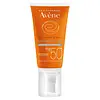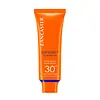What's inside
What's inside
 Key Ingredients
Key Ingredients

 Benefits
Benefits

 Concerns
Concerns

 Ingredients Side-by-side
Ingredients Side-by-side

Water
Skin ConditioningC12-15 Alkyl Benzoate
AntimicrobialDicaprylyl Carbonate
EmollientMethylene Bis-Benzotriazolyl Tetramethylbutylphenol
UV FilterDiisopropyl Adipate
EmollientSilica
AbrasiveBis-Ethylhexyloxyphenol Methoxyphenyl Triazine
Skin ConditioningDiethylhexyl Butamido Triazone
UV AbsorberAlcohol
AntimicrobialAluminum Starch Octenylsuccinate
AbsorbentButyl Methoxydibenzoylmethane
UV AbsorberC10-18 Triglycerides
EmollientDecyl Glucoside
CleansingGlyceryl Stearate
EmollientPEG-100 Stearate
Potassium Cetyl Phosphate
EmulsifyingAcrylates/C10-30 Alkyl Acrylate Crosspolymer
Emulsion StabilisingAscophyllum Nodosum Extract
Skin ConditioningBenzoic Acid
MaskingCaprylic/Capric Triglyceride
MaskingCaprylyl Glycol
EmollientDisodium EDTA
Glyceryl Behenate
EmollientGlyceryl Dibehenate
EmollientPropylene Glycol
HumectantSodium Hydroxide
BufferingStearyl Alcohol
EmollientTocopherol
AntioxidantTocopheryl Glucoside
EmollientTribehenin
EmollientXanthan Gum
EmulsifyingWater, C12-15 Alkyl Benzoate, Dicaprylyl Carbonate, Methylene Bis-Benzotriazolyl Tetramethylbutylphenol, Diisopropyl Adipate, Silica, Bis-Ethylhexyloxyphenol Methoxyphenyl Triazine, Diethylhexyl Butamido Triazone, Alcohol, Aluminum Starch Octenylsuccinate, Butyl Methoxydibenzoylmethane, C10-18 Triglycerides, Decyl Glucoside, Glyceryl Stearate, PEG-100 Stearate, Potassium Cetyl Phosphate, Acrylates/C10-30 Alkyl Acrylate Crosspolymer, Ascophyllum Nodosum Extract, Benzoic Acid, Caprylic/Capric Triglyceride, Caprylyl Glycol, Disodium EDTA, Glyceryl Behenate, Glyceryl Dibehenate, Propylene Glycol, Sodium Hydroxide, Stearyl Alcohol, Tocopherol, Tocopheryl Glucoside, Tribehenin, Xanthan Gum
Water
Skin ConditioningDiisopropyl Sebacate
EmollientOctocrylene
UV AbsorberAlcohol
AntimicrobialPropylene Glycol
HumectantButyl Methoxydibenzoylmethane
UV AbsorberCyclopentasiloxane
EmollientGlycerin
HumectantTribehenin PEG-20 Esters
EmollientDiethylhexyl Butamido Triazone
UV AbsorberEthylhexyl Methoxycinnamate
UV AbsorberTitanium Dioxide
Cosmetic ColorantPotassium Cetyl Phosphate
EmulsifyingPolymethylsilsesquioxane
Methylene Bis-Benzotriazolyl Tetramethylbutylphenol
UV FilterAlpha-Isomethyl Ionone
PerfumingAluminum Hydroxide
EmollientAluminum Stearate
Cosmetic ColorantAngelica Archangelica Root Extract
MaskingAscorbic Acid
AntioxidantAscorbyl Palmitate
AntioxidantBenzyl Benzoate
AntimicrobialBHT
AntioxidantC30-45 Alkyl Cetearyl Dimethicone Crosspolymer
EmollientCalcium Sodium Phosphosilicate
Camellia Sinensis Leaf Extract
AntimicrobialCaprylyl Glycol
EmollientCinnamal
PerfumingCinnamyl Alcohol
PerfumingCitric Acid
BufferingCitronellol
PerfumingCitrus Aurantium Amara Peel Extract
MaskingCoffea Arabica Seed Extract
MaskingCyclohexasiloxane
EmollientDecyl Glucoside
CleansingDimethylmethoxy Chromanol
AntioxidantDisodium EDTA
Farnesol
PerfumingGeraniol
PerfumingHdi/Trimethylol Hexyllactone Crosspolymer
Hippophae Rhamnoides Oil
EmollientHydroxycitronellal
PerfumingHydroxyethyl Acrylate/Sodium Acryloyldimethyl Taurate Copolymer
Emulsion StabilisingLecithin
EmollientLinalool
PerfumingMagnesium Aluminum Silicate
AbsorbentMaltodextrin
AbsorbentMauritia Flexuosa Fruit Oil
Skin ConditioningMica
Cosmetic ColorantPalmitic Acid
EmollientPEG-8
HumectantPolysorbate 60
EmulsifyingPongamia Pinnata Seed Extract
Skin ConditioningRuby Powder
Skin ConditioningSclerotium Gum
Emulsion StabilisingSorbitan Isostearate
EmulsifyingStearic Acid
CleansingSynthetic Fluorphlogopite
Tin Oxide
AbrasiveTocopherol
AntioxidantXanthan Gum
EmulsifyingChlorphenesin
AntimicrobialPhenoxyethanol
PreservativeSorbic Acid
PreservativeParfum
MaskingCI 14700
Cosmetic ColorantCI 77891
Cosmetic ColorantWater, Diisopropyl Sebacate, Octocrylene, Alcohol, Propylene Glycol, Butyl Methoxydibenzoylmethane, Cyclopentasiloxane, Glycerin, Tribehenin PEG-20 Esters, Diethylhexyl Butamido Triazone, Ethylhexyl Methoxycinnamate, Titanium Dioxide, Potassium Cetyl Phosphate, Polymethylsilsesquioxane, Methylene Bis-Benzotriazolyl Tetramethylbutylphenol, Alpha-Isomethyl Ionone, Aluminum Hydroxide, Aluminum Stearate, Angelica Archangelica Root Extract, Ascorbic Acid, Ascorbyl Palmitate, Benzyl Benzoate, BHT, C30-45 Alkyl Cetearyl Dimethicone Crosspolymer, Calcium Sodium Phosphosilicate, Camellia Sinensis Leaf Extract, Caprylyl Glycol, Cinnamal, Cinnamyl Alcohol, Citric Acid, Citronellol, Citrus Aurantium Amara Peel Extract, Coffea Arabica Seed Extract, Cyclohexasiloxane, Decyl Glucoside, Dimethylmethoxy Chromanol, Disodium EDTA, Farnesol, Geraniol, Hdi/Trimethylol Hexyllactone Crosspolymer, Hippophae Rhamnoides Oil, Hydroxycitronellal, Hydroxyethyl Acrylate/Sodium Acryloyldimethyl Taurate Copolymer, Lecithin, Linalool, Magnesium Aluminum Silicate, Maltodextrin, Mauritia Flexuosa Fruit Oil, Mica, Palmitic Acid, PEG-8, Polysorbate 60, Pongamia Pinnata Seed Extract, Ruby Powder, Sclerotium Gum, Sorbitan Isostearate, Stearic Acid, Synthetic Fluorphlogopite, Tin Oxide, Tocopherol, Xanthan Gum, Chlorphenesin, Phenoxyethanol, Sorbic Acid, Parfum, CI 14700, CI 77891
Ingredients Explained
These ingredients are found in both products.
Ingredients higher up in an ingredient list are typically present in a larger amount.
Alcohol comes in many different forms. Different types of alcohol will have different effects on skin. This ingredient is usually an astringent alcohol.
These alcohols are drying on the skin. They may strip away your skin's natural oils and even damage your skin barrier. Astringent alcohols may also irritate skin.
Other types of astringent alcohols include:
According to the National Rosacea Society based in the US, you should be mindful of products with these alcohols in the top half of ingredients.
Any type of sanitizing product will have high amounts of alcohol to help kill bacteria and viruses.
Fatty alcohols come from plant oils such as coconut oil. These can help hydrate the skin and are non-irritating. Some fatty alcohols include cetyl and stearyl alcohol.
Learn more about AlcoholAlso known as Avobenzone, this ingredient is a chemical sunscreen filter that provides protection in the UV-A range.
Avobenzone is globally approved and is the most commonly used UV-A filter in the world.
Studies have found that avobenzone becomes ineffective when exposed to UV light (it is not photostable; meaning that it breaks down in sunlight). Because of this, formulations that include avobenzone will usually contain stabilizers such as octocrylene.
However, some modern formulations (looking at you, EU!) are able to stabilize avobenzone by coating the molecules.
Avobenzone does not protect against the UV-B range, so it's important to check that the sunscreen you're using contains other UV filters that do!
The highest concentration of avobenzone permitted is 3% in the US, and 5% in the EU.
Learn more about Butyl MethoxydibenzoylmethaneCaprylyl Glycol is a humectant and emollient, meaning it attracts and preserves moisture.
It is a common ingredient in many products, especially those designed to hydrate skin. The primary benefits are retaining moisture, skin softening, and promoting a healthy skin barrier.
Though Caprylyl Glycol is an alcohol derived from fatty acids, it is not the kind that can dry out skin.
This ingredient is also used as a preservative to extend the life of products. It has slight antimicrobial properties.
Learn more about Caprylyl GlycolDecyl Glucoside is a glucose-based surfactant and emulsion stabilizer. It is created by reacting glucose with the fatty acids from plants.
Surfactants help clean the skin by trapping oil, sebum, and dirt to be washed away. As an emulsion stabilizer, it stabilizes the ingredients in a product by preventing them from separating.
This ingredient is biodegradable and non-toxic. This ingredient is commonly found in baby shampoos.
Decyl Glucoside is sometimes used to stabilize the UV filter Tinosorb.
Learn more about Decyl GlucosideDiethylhexyl Butamido Triazone is a photostable UV absorber. It protects in both the UVB and UVA II range.
The great thing about this ingredient is that it is ultra-photostable at low concentrations.
It is also pretty water-resistant and is highly oil-soluble (so your oil cleanser will get it off right away).
This ingredient is currently available in Europe and Japan, but not in the US.
Learn more about Diethylhexyl Butamido TriazoneDisodium EDTA plays a role in making products more stable by aiding other preservatives.
It is a chelating agent, meaning it neutralizes metal ions that may be found in a product.
Disodium EDTA is a salt of edetic acid and is found to be safe in cosmetic ingredients.
Learn more about Disodium EDTAMethylene Bis-Benzotriazolyl Tetramethylbutylphenol (Tinosorb M) is a hybrid and broad-spectrum UV ingredient. It is both a UV absorber and filter.
UV absorbers are an agent that absorbs UV rays. They protect your skin by using chemical reactions to convert UV rays into heat and energy. UV filters physically reduce the amount of UV rays from reaching your skin.
Tinosorb M covers a range of 280-400 nm and is photostable. This ingredient is neither oil or water soluble.
Tinosorb M is not available in the US. However, it is available in the EU and Asia.
It's sister, Tinosorb S, is set to be approved in the US by late 2025 (fingers crossed!).
Learn more about Methylene Bis-Benzotriazolyl TetramethylbutylphenolPotassium Cetyl Phosphate is the potassium salt of a mixture. This mixture consists of the esters from phosphoricacid and cetyl alcohol.
Potassium Cetyl Phosphate is an emulsifier and cleansing agent. Emulsifiers help stabilize a product. It does this by preventing certain ingredients from separating.
As a cleansing agent, Potassium Cetyl Phosphate helps gather oils, dirts, and pollutants from your skin. This makes it easier to rinse them away with water.
Learn more about Potassium Cetyl PhosphatePropylene Glycol is an odorless, colorless liquid. As a humectant, it helps skin retain moisture. It also aids in delivering active ingredients.
Another role of this ingredient is preventing a product from melting or freezing. Propylene glycol also adds antimicrobrial properties to a product, elongating product lifespan.
This ingredient is considered an organic alcohol and commonly added into both cosmetics and foods.
Those with sensitive skin or conditions may develop a rash when using this ingredient.
Learn more about Propylene GlycolTocopherol (also known as Vitamin E) is a common antioxidant used to help protect the skin from free-radicals and strengthen the skin barrier. It's also fat soluble - this means our skin is great at absorbing it.
Vitamin E also helps keep your natural skin lipids healthy. Your lipid skin barrier naturally consists of lipids, ceramides, and fatty acids. Vitamin E offers extra protection for your skin’s lipid barrier, keeping your skin healthy and nourished.
Another benefit is a bit of UV protection. Vitamin E helps reduce the damage caused by UVB rays. (It should not replace your sunscreen). Combining it with Vitamin C can decrease sunburned cells and hyperpigmentation after UV exposure.
You might have noticed Vitamin E + C often paired together. This is because it is great at stabilizing Vitamin C. Using the two together helps increase the effectiveness of both ingredients.
There are often claims that Vitamin E can reduce/prevent scarring, but these claims haven't been confirmed by scientific research.
Learn more about TocopherolWater. It's the most common cosmetic ingredient of all. You'll usually see it at the top of ingredient lists, meaning that it makes up the largest part of the product.
So why is it so popular? Water most often acts as a solvent - this means that it helps dissolve other ingredients into the formulation.
You'll also recognize water as that liquid we all need to stay alive. If you see this, drink a glass of water. Stay hydrated!
Learn more about WaterXanthan gum is used as a stabilizer and thickener within cosmetic products. It helps give products a sticky, thick feeling - preventing them from being too runny.
On the technical side of things, xanthan gum is a polysaccharide - a combination consisting of multiple sugar molecules bonded together.
Xanthan gum is a pretty common and great ingredient. It is a natural, non-toxic, non-irritating ingredient that is also commonly used in food products.
Learn more about Xanthan Gum